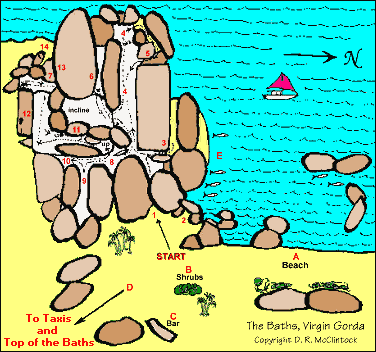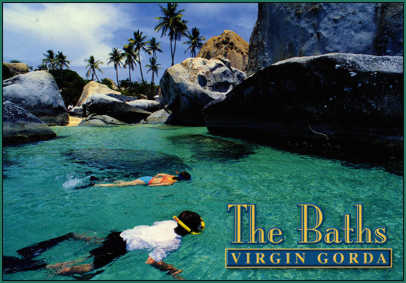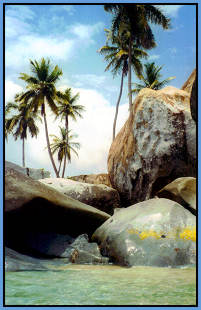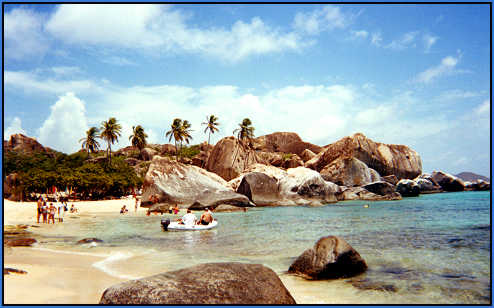Virgin Gorda BVI The Baths Map
by D. R. McClintock
I first visited the Baths with charter guests in 1983, and since then have
visited them countless times. I developed a map to help my charter
guests find their way around the Baths' many intricate passageways.
While using it, my guests were invariably pressed into service as tour
guides for other explorers.
The map is intended to help visitors find their way through the maze
of boulders, and to help them discover its most interesting features. While
an attempt has been made to draw it roughly to scale, there are in fact
many more, smaller boulders on the site than are indicated. This is especially
so to the south towards Devil's Bay. To follow the course indicated on
the map will take approximately 45 minutes to an hour. I hope that the
map will help visitors to discover the hidden beauty of the Baths.
 Click on Map for larger image.
Click on Map for larger image.
Key to Using the Map
A. Beach. Dinghy landings are prohibited, but there is a dinghy
mooring and you can swim to the beach.
B. Shrubs. You may leave snorkeling equipment while exploring
the boulders. Also, site of vendors selling T-shirts and shells.
C. Poor Man's Bar. Sells drinks, hamburgers, T-shirts.
D. Trail to taxi drop-off, about a 7 minute easy walk.
E. Snorkeling is quite good in this area for fish; also, to the
north where you can find Elk Horn Coral formations. West of the dinghy
landing.
1. Entrance. You'll have to crouch and waddle like a duck here!
2. Shelf Boulder. Note fault through top of adjacent boulder
to right of this boulder.
3. North Cabe. Note deep holes caused by uneven erosion. Also,
note the size of this boulder, one of the largest here.
4. "The Baths." A great photo opportunity! Notice on the huge
boulder to your right the beautiful markings caused by chemical reaction
of rain water (weak carbonic acid) with minerals.
5. The Throne. Another fun photo opportunity.
6. Ship's Keep Boulder. As you stand under this boulder look
at its shape. Doesn't it look like the keel of a sailboat to you?
7. Walk under the ship's keel as far as you can to the south, then turn
around and look up. This magnificent tunnel is Neptune's Hideaway.
Notice the pitting on the boulders on your left. Now retrace your steps
back out to the edge of the first pool.
8. The Cathedral. Look up and marvel at the limited points of
contact between the massive boulders above you!
9. Tarzan Land. The roots are of pomegranate trees which you'll
see when you climb above in a moment or two.
10. Boulder House. Notice how dry it is in here, even when it
rains. Now retrace your steps a few yards and turn to your left and start
up the incline. Look to you right to see ...
11. Geodesic Cave. One of the prettiest, most intricate of the
caves. Another great photo opportunity. Continue to climb up. Just as you
emerge between the two boulders, look ahead to see ...
12. Whale's Head. Notice to the left of the whale's mouth an
obelisk which was once part of the Whale's Head boulder. Stand near the
obelisk now and look to the west to find the entrance to Neptune's Hideaway.
Now a new shape has emerged!
13. Lion's Head. Start at the top of the boulder and let your
eye follow the line down to the left. Do you see the lion's forehead and
nose? See his upper jaw, his eye, the markings on his face and his
mane.
14. Ethiopian Head. A striking formation to the left of the lion.
 HISTORY
HISTORY
The most famous site in the British Virgin Islands is the Baths on
Virgin Gorda, and visitors to the island rarely miss a visit to these magnificent
boulders and the sheltered pools for which the Baths are named. They are
also a regular stopover on the British Virgin Islands' charter boat circuit.
Indeed, they are so popular that charter vessels from St. Thomas in the
U.S. Virgin Islands motor to the Baths every day. Yachtsmen anchor just
to the west of the site and swim to shore.
As the skippers of Camelot, a 51 foot charter yacht, my wife Mavis and
I are frequent visitors to the Baths. Invariably our charter guests are
overwhelmed by the sight of these mansion sized boulders piled atop one
another. As these awed explorers stroll along the beach, wade through the
pools and explore the innumerable passageways above and below the boulders,
they repeatedly ask the same questions: How did such massive boulders get
here in the first place? What were the forces that raised them into place?
How long have they been here? How did they develop into such fantastic
shapes? And, especially, how did the mysterious caves and deep holes
form within the boulders themselves?
Many of these questions can be answered by geologists, and a detailed
look at the geology of the Baths can be found in Charles A. Ratte's booklet,
The Story of the Boulders, which is sold at the Virgin Gorda Yacht Harbour.
 In
his book, Dr. Ratte explains that the oldest rocks in the Virgin Islands
began to form approximately 120 million years ago as the result of volcanic
action. However, the granite boulders of Virgin Gorda did not appear
until the Tertiary Period, approximately 70 million years ago. At
that time, molten rock called magma found its way into the newly formed
layers of lava on the seabed of the Caribbean. The accumulation of magma
gradually formed huge sections of granite, consisting mainly of feldspar
and quartz. About 15 to 25 million years ago, faulting and uplifting
of the sea floor occurred. The granite which by now formed part of the
sea floor was thus exposed, initially in the form of rather more squared
boulders, rather than the rounded remains which we now observe. Originally
these boulders were more massive. However, fault lines developed,
causing them to break into smaller pieces, which rested atop and alongside
of one another. In
his book, Dr. Ratte explains that the oldest rocks in the Virgin Islands
began to form approximately 120 million years ago as the result of volcanic
action. However, the granite boulders of Virgin Gorda did not appear
until the Tertiary Period, approximately 70 million years ago. At
that time, molten rock called magma found its way into the newly formed
layers of lava on the seabed of the Caribbean. The accumulation of magma
gradually formed huge sections of granite, consisting mainly of feldspar
and quartz. About 15 to 25 million years ago, faulting and uplifting
of the sea floor occurred. The granite which by now formed part of the
sea floor was thus exposed, initially in the form of rather more squared
boulders, rather than the rounded remains which we now observe. Originally
these boulders were more massive. However, fault lines developed,
causing them to break into smaller pieces, which rested atop and alongside
of one another.
As millions of years passed, weathering and erosion occurred.
One of the most important sources of erosion is rain water. As it falls,
the rain reacts with carbon dioxide and a very weak form of carbonic acid
results. All of the minerals which form granite, except quartz, react
readily with carbonic acid, and erosion and pitting, as well as fluting
of the boulders occurs. If you observe the surface of the boulders
you will notice that in many places the rough surface appears to be flaking.
The roughness is caused by particles of quartz which are exposed, but
still held in place by the minerals not yet eroded around them.
Large caves carved out of the rocks and a massive tunnel through one
of the boulders are additional features of the Baths. Dr. Ratte explains
that such hollow boulders are formed by prevalent easterly and southeasterly
winds. These provide additional moisture on the most exposed rock face;
resulting in an accelerated erosion which gradually develops a ledge or
canopy on the face of the rock. Dampness within the shaded canopy, furthers
the erosion and hollowing process. Over millions of years, this steady
erosion has created the substantial caves that fascinate visitors.
The Baths are not just for exploring, though. The white sand beach is
ideal for sunning, and the clear waters for swimming and snorkeling.
For snorkelers interested in seeing fish, the snorkeling is best near the
rocks to the south of the dinghy landing beach, and around the rocks just
to the west. There is quite a substantial colony of elk horn coral formations
to the north of the beach area. Look, but don't touch these fragile formations.
As you visit this beautiful area, which is now part of the British Virgin
Islands National Parks Trust, do respect its fragile nature: deposit all
trash in the appropriate receptacle, or even better, take it away with
you. And kindly refrain from defacing any of the boulders, or damaging
them in any way. As you wander through this incredible geological
site, you will be filled with a sense of the wonder of our universe, of
which we are but a tiny, very finite part. |


